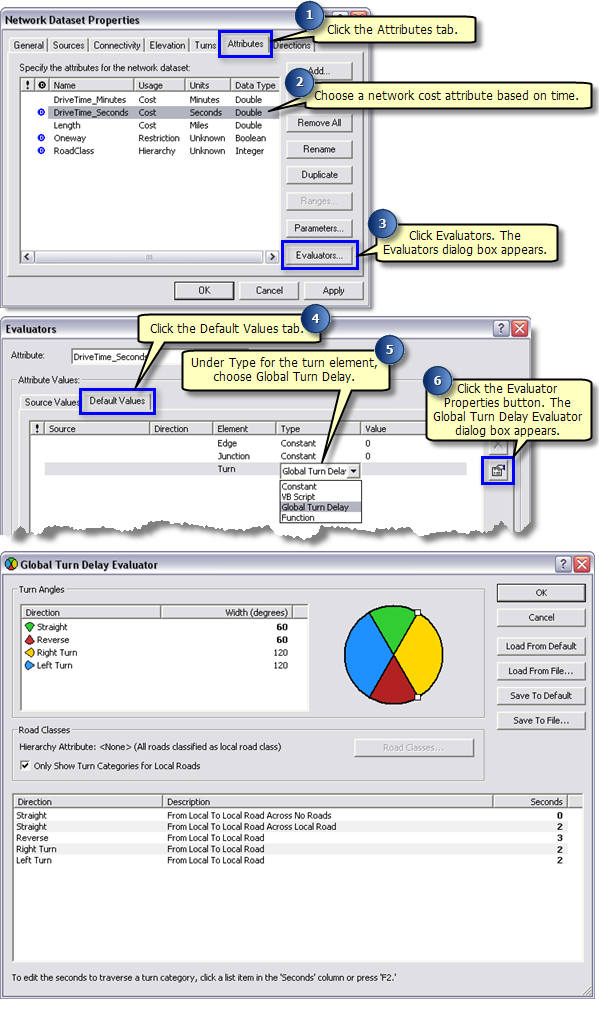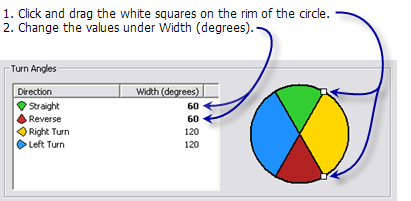Extensions > Network Analyst > Building and editing the network dataset
Establishing global turns |
|
|
Release 9.3
Last modified March 2, 2010 |



Print all topics in : "Building and editing the network dataset" |
About the global turn delay evaluator
Global turns are implicitly present at every transition between two adjacent edges within a network dataset where there is not already a turn feature present. The main purpose of global turns is to improve travel time estimates by penalizing turn movements not already represented or restricted by turn features.
First, a global turn delay evaluator works by classifying two-edge transitions into four general turn types: left, right, reverse, and straight turns. (A reverse turn is like a U-turn, and a straight turn describes the movement of continuing directly ahead at an intersection.) Second, the evaluator penalizes transitions between edges based on the values you provide. For example, if you give global left turns a penalty of 15 seconds, the global turn delay evaluator finds all adjacent edges that are left turns and penalizes them by 15 seconds. The global turn delay evaluator is able to use hierarchies to classify and penalize turns more accurately. For instance, it can recognize a left turn from a local road to a secondary road and penalize it more than a left turn from a local road to another local road.
Global turns can be used with or without turn features present in a network dataset. Typically, turn features have more accurate penalties because each feature models a specific turn maneuver at an intersection; however, creating turn features for every turn, or even most turns, in a network is often infeasible because of the sheer quantity of turns that are possible. Alternatively, you can quickly set up global turns by defining turn angles for the four turn directions and assigning penalties for each turn type. You should note that global turns are typically not as accurate as turn features because they are generalized and only penalize two-edge turns. Balancing these trade-offs between accuracy and ease of design can be accomplished by creating turn features at important intersections and invoking a global turn delay evaluator for the other areas of a network dataset.
The values of a global turn delay evaluator can be changed without having to rebuild the network dataset.
To make any schema changes (such as changing turn penalty values or turn angles), an exclusive schema lock on the network dataset is required because two applications (ArcMap and ArcCatalog) could make conflicting changes and damage the network dataset.
Global turn types
Straight, reverse, right, and left turns
Global turns are classified into four main categories based on their turn angles: straight, reverse, right, and left turns. A vehicle going through an intersection must perform one of these four turn types.
To demonstrate how a turn is classified into one of these four types, the graphics below have white arrows that indicate the movement of a vehicle through an intersection. The pie chart, which is taken from the Global Turn Delay Evaluator dialog box, is oriented so that the vehicle approaches an intersection from the center of the red area at the bottom of the circle. When the turn angle from one edge to another edge points the vehicle toward the blue area, the vehicle has performed a left turn. When the vehicle angles toward the green area, it has performed a straight turn. Yellow and red capture right and reverse turns, respectively.

Changing the angles that classify turns is possible. For example, you can narrow the straight-turns wedge and widen the reverse-turns wedge, which consequently affects the left- and right-turn wedges. By doing so, the arrows that represent the straight and right turns from the graphics above are correspondingly reclassified as left and reverse turns in the graphics below.

Since the turn classification can change, the turn penalty can also change. For instance, the original straight turn might have a penalty of only 2 seconds, whereas the same turn, reclassified as a left turn in the second graphic, might have a penalty of 5 seconds.
Turns based on hierarchies
The time it takes to negotiate an intersection frequently depends on the volume of cross traffic; moreover, traffic volumes are likely to correlate with road hierarchies. For instance, a left turn from a local road onto a secondary road typically involves waiting for a break in traffic or on a traffic light that favors the secondary road. Yet left turns from local roads onto other local roads tend to have a shorter delay because there is less cross traffic and usually only a yield or stop sign.
If your network uses a hierarchy, the global turn delay evaluator is enabled to model turn penalties in more detail by classifying turns according to the hierarchical classes of the roads involved in the turn. You could therefore choose to assign left turns from local roads to secondary roads a penalty of 10 seconds while assigning left turns from local roads to local roads a two-second penalty.
Learn more about hierarchy network attributes.
When your network doesn't use hierarchies, all turns are considered part of the same road class: local roads.
Units of global turn penalties
Global turn penalties are modeled using seconds. Consequently, global turn delay evaluators can only be used with network cost attributes based on time (such as minutes or seconds).
You can estimate or measure the average number of seconds it takes your vehicle to make the various types of turns and assign those values to the corresponding turn types on the Global Turn Delay Evaluator dialog box.
Solving network problems with global turns
Once a global turn delay evaluator is defined for a cost attribute, turns are penalized anytime you use that cost attribute within a network problem either as the impedance or an accumulated attribute.
Accessing the Global Turn Delay Evaluator dialog box
The Global Turn Delay Evaluator dialog box is accessed in ArcCatalog through the Network Dataset Properties dialog box by following these steps:

NOTE: Since the global turn delay evaluator is new in ArcGIS 9.3, using it in your network dataset will make your network dataset unusable in previous ArcGIS releases. Furthermore, if you are using a geodatabase, it must be a 9.3 version.
Turn angles
Turn angles are used to classify movements between adjacent edges into straight, reverse, right, and left turns. The Turn Angles section of the Global Turn Delay Evaluator dialog box allows you to set straight and reverse turn angles, which implicitly set right and left turns. Both straight and reverse turns have minimum and maximum values of 0 and 180 degrees. The dialog box allows you to specify turn angles both graphically and numerically.
To change turn angles, do one of the following:

The global turn delay evaluator first evaluates the turning angle, then it evaluates the road class. If the angle falls within the right-turn range, it will make that determination first and, if necessary, inspect adjacent streets to determine hierarchies.
Road classes
The Road Classes section of the dialog box is related to hierarchies.
If you have a hierarchy network attribute in the network dataset, the Road Classes button allows you to set hierarchy ranges, and the table will have 20 or more turn types and penalty values. If you don't have a hierarchy attribute in your network dataset, the Only Show Turn Categories for Local Roads check box is checked by default so you only need to set penalties for one road class. You can also uncheck Only Show Turn Categories for Local Roads to set up delays for other road classes as if there were a hierarchy. This allows you to prepare the global turn delay evaluator for any hierarchy attribute you add later. Until you add a hierarchy attribute to your network dataset, the global turn delay evaluator will treat all roads as local roads.
Seconds table
The table at the bottom of the Global Turn Delay Evaluator dialog box lists the turn types and their corresponding impedance values, which you can edit. To change a single penalty value, click a row in the Seconds column and enter a value. To change several turn delay values at once, make multiple selections by holding the Ctrl or Shift key and clicking rows, then click in the Seconds column of one of the selected rows and type a value.
How to set up a global turn delay evaluator
- Start ArcCatalog.
- Navigate to the network dataset location in the Catalog tree and double-click it to open the Network Dataset Properties dialog box.
- Click the Attributes tab.
- Select a cost attribute that has a time-based unit (for example, seconds or minutes).
- Click Evaluators.
- In the Evaluators dialog box, click the Default Values tab.
- Under Type for the Turn element, select Global Turn Delay.
- Click the Evaluator Properties button.
- Choose how you want to define straight and reverse turns and either accept the default values or enter new ones in the Turn Angles section of the Global Turn Delay Evaluator.
- For each turn type in the table at the bottom of the dialog box, enter a turn penalty value in the Seconds column.
- Click OK in the Global Turn Delay Evaluator dialog box.
- Click OK to close the Evaluators dialog box.
- Click OK to close the Network Dataset Properties dialog box.